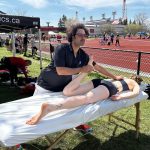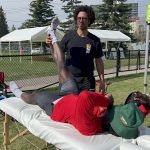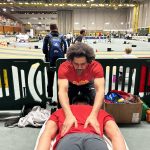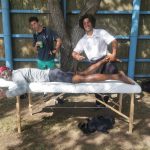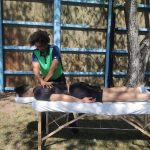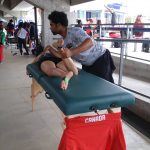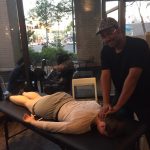
(version anglaise seulement)
Have we ever found ourselves in a more exciting time for mental health awareness than today? Armed with current research, better education, social media (yes, social media) and a strong public conscious that urges acceptance for expressionism, our societies have developed strong understandings regarding what depression is and how it impacts our overall health.
Maintaining overall health is one of the primary targets for clinical massage therapy. Evidence-informed clinical massage therapists constantly aim to better the well-being of their patients through the use of strategic soft-tissue manipulation and corrective exercises. When we look at specific ways for treating depression, we find that there are several options for treatment, which are dependent on how the patient presents, varying in effectiveness. From a holistic perspective, massage therapy can be used to treat depression in several ways that benefits the overall health of such individuals (1, 2, 3). Let’s explore the nature of depression and how massage could be a game changer.
So What Is Depression?
Depression is a major depressive mood disorder that globally affects 4.4% to 20% of the population (7). It presents with disturbances in emotional states that cause subjective discomfort and/or interferes with the ability to function. Depression can manifest when feelings of intense sadness, hopelessness, worthlessness and futility, arising for prolonged periods of time, and will often but not always be accompanied by somatic (pertaining to the body) symptoms such as chronic pain (13, 14).
Depression symptoms can vary from mild to severe and can include:
- Feeling sad or having a depressed mood.
- Loss of interest or pleasure in activities once enjoyed.
- Changes in appetite — weight loss or gain which is unrelated to dieting.
- Trouble sleeping or sleeping too much.
- Loss of energy or increased fatigue.
- Increase in purposeless physical activity (e.g., hand-wringing or pacing).
- Observably slower movements and speech.
- Feeling worthless or guilty.
- Difficulty thinking, concentrating, or making decisions.
- Thoughts of death or suicide.
Symptoms must last at least two weeks for a diagnosis of depression.
It is normal for people to experience grief or sadness (such as losing a loved one to cancer), this is natural! The important distinction occurs when these feelings perpetuate beyond two weeks, or when one experiences a reoccurrence of depressed episodes.
There is very little agreeance amongst the medical community as to a singular cause of depression. The best evidence so far indicates several external and internal factors that, together, play a role in the pathophysiology and manifestation of the depressive state. Some of these factors include past trauma, changes to sleep patterns, neurochemistry, personality and genetics (5).
So What Does Current Research Tell Us?
The ability of massage therapy to positively influence depression has been shown to be quite significant, notably when individuals are subjected to a course of several treatments (1). Trait anxiety, different than state anxiety, is viewed more as a personality trait. A natural tendency towards becoming anxious. This a common symptom associated with depression and has been under tremendous scientific scrutiny. The University of Illinois published a meta-analysis that showed massage therapy can reduce trait anxiety by 77% and depression by 73% respectively (1). This is incredible! The paper goes on to stipulate that psychotherapy fares in the same percentage of effectiveness, and describes how the structure of a massage treatment parallels that of psychotherapy.
Our advice? Clearly massage therapy has potential to serve as powerful adjunct therapy and could be the very thing you’re missing to ameliorate your well-being.
In spite of the lack of research to show an exact mechanism of action for the effectiveness of massage, there is robust evidence to show systemic positive changes following a massage that may improve the prognosis of depressed individuals (1, 2, 3, 4, 6, 9, 10). Three potential mechanisms that are associated with depression are of particular interest to massage therapists. Systemic inflammation, chronic pain and neurochemical imbalances. Let’s take a look at each of these.
Systemic Inflammation
Inflammation is the body’s natural response to injury. It is normally short-lived with beneficial health effects. Systemic chronic inflammation lasts longer and can have negative effects. The Corticotropin Releasing Hormone (CRH) is commonly found in elevated levels amongst depressed individuals (5). This hormone plays a direct role in the function of the HPA Axis, a system that regulates important bodily functions such as mood, digestion, stress, emotion, sexuality and the immune system. When this system becomes deregulated due to increased hypothalamic secretions of CRH, in response to stress, the body goes into protective mode and answers with a cascade of inflammatory responses. This is the fight-or-flight response. It has been shown that depressed individuals have chronically elevated levels of inflammatory chemicals (cytokines TNF-a and IL-6) (4, 5, 7). Systemic inflammation is mediated by inflammatory chemicals, and due to this chronically inflamed state, the body continues to produce more CRH and the stress hormone cortisol (5, 12). Simply put, the body is trying to heal and eradicate stress but can’t identify where to begin.
Effects of Massage on Systemic Inflammation
Within this context, massage can improve circulation, reduce the abundance of circulating chemicals and reduce cortisol levels. Interestingly enough, cortisol is actually a powerful vasoconstrictor via its influence on the endothelial and smooth muscle cells (11). This makes it very difficult for the body to maintain homeostatic blood circulation. More on cortisol later but for now lets focus on why improved circulation is important. Without adequate vascular tone this inflammation will stay trapped wherever it may, causing pain and keeping you stressed. Essentially, hypertension. Improving circulation can be achieved by several means but you shouldn’t have to take a drug for that.
Amazingly, massage can temporarily (72 hours) and systemically alter arterial function and improve circulation after just a single 30min treatment that uses Swedish massage techniques (6). A 2014 study (the first of its kind) showed that massage therapy causes widespread vasodilation by restoring endothelial function (6). It is been established that the mechanism behind this action is due to the activation of specific mechanotransduction signaling pathways and the direct attenuation of inflammatory chemicals (4). In summary, massage therapy demonstrates a means by which a cycle of inflammation can be reduced and potentially corrected over the course of several treatments.
Chronic Pain
It is now understood that depressed individuals have higher incidences of chronic pain than non-depressed individuals. Pain and depression have strong correlations, although it is unclear which one leads to another (12, 13). Sometimes it is trauma that is the most significant causal factor. A massive review study published in 2018 looked at the effectiveness of massage when treating a variety of chronic pain conditions and found that massage significantly reduced pain and increased function in every chronic pain study over the past decade (10).
Using Massage to Reduce Chronic Pain
Whether it is TMJ, hand pain, foot pain, shoulder pain, headaches, fibromyalgia or myofascial pain massage, will help. In clinic, we overwhelmingly see patients who are suffering from chronic pain. Everyday we see how massage therapy is positively impacting the lives of our patients. And the scientific literature supports this.
Neurochemical Imbalances
Depressed individuals suffer from the consequences of unbalanced neurochemistry. We know this because classes of drugs such as SSRIs and SSNIs do help people. However, when time is taken to talk to these patients many of them will tell you that the results aren’t as effective as they hoped or that the side effects become to much to bear (14). Massage therapy achieves antidepressant effects by altering body chemistry and activating the autonomic nervous system to reduce vagal tone (1, 9). Measuring vagal tone excitement gives us direct insight into how touch affects degrees of heightened emotional states. Several studies have investigated the effect of massage on specific hormones associated with depression (1, 2, 5, 9). Elevating serotonin and dopamine is associated with positive outcomes when treating depression (5). Both hormones across populations have be shown to increase significantly following a massage when compared to a control (2). This study also observed significant reductions in cortisol levels (2). This evidence is further strengthened by a meta-analysis of massage research and a smaller study that also demonstrated a reduction in the stress hormone norepinephrine (1, 9).
Using Massage to Balance Your Neurochemistry
To date, there is enough evidence to suggest that massage therapy can help tackle depression by influencing body chemistry. This has huge clinical implications in that massage should be explored before relying on drugs, and certainly as an adjunct therapy for developing effective strategies for improving the lives of depressed people. More research is needed to validate this hypothesis, massage vs antidepressant or massage + antidepressant vs antidepressant. This must be investigated further.
Alright, So What Should You Do?
It is clear that massage can have a positive affect on those suffering from depression. So should you only get a massage and claim it is a cure all? Of course not.
Our belief is that apply an integrated, evidence-informed strategy is optimal and treatment should be approached based on the needs of each individual. Every case is different, and this must be respected in order to provide the best treatment possible.
The evidence to support exercise as a treatment is strong (8). The evidence to support psychotherapy and antidepressants is firm (14, 15). Listen to your primary health care provider and trust in their knowledgeable experience. Implement exercise, ideally with supervision, and seek massage therapy as adjuncts to your treatment strategies. With this in mind, remission and life-changing improvements are not only possible but are a realistic achievable goal.
Doctors should be open to this discussion and will guide you appropriately. The therapist needs to provide an efficacious treatment whilst encouraging and motivating the patient to pursue the appropriate corrective exercise. And of course, you must never give up in the pursuit of happiness.
General Treatment Plan Expectations
A depressed patient should expect a treatment plan ranging from 5-10 sessions. Positive effects may be noticed after just 2-3 sessions. The patient should see their massage therapist once or twice a week, gradually adjusting treatment frequency of visits as improvements are made. Focus of the session will be relaxation and more advanced techniques will be used if needed to treat any chronic pain or soft-tissue dysfunction. Hydrotherapy may be used to control inflammation, promote circulation and ease tension. It is within the massage therapy scope of practice to provide reassurance and neutral feedback. As such, the treatment room can also be used as a safe space for the patients to voice themselves. Finally, corrective exercises and home care strategies for reducing stress (such as breath work, meditation, Epsom salt baths) can be given as indicated.
References
- Christopher A Moyer, James Rounds, James W. Hannum. 2014. A Meta-Analysis of Massage Therapy Research. Psychological Bulletin 130;1:3-18
- Tiffany Field, Maria Hernandez-Reif, Miguel Diego, Saul Schanberg, Cynthia Kuhn. 2005. Cortisol decreases and serotonin increases following massage therapy. International Journal of Neuroscience 115;10:1397-1413
- Wen-Hsuan Hou, Pai-Tsung Chiang, Tun-Yen Hsu, Su-Ying Chiu. 2010. Treatment Effects of Massage Therapy in Depressed People: A Meta-Analysis. The Journal of Clinical Psychiatry 71;7:894-901
- Justin Crane, Daniel I Ogborn, Colleen Patricia Cupido, Mark Tarnopolsky, Simon Melov, Alan E Hubbard, Jacqueline M Bourgeois. 2012. Massage Therapy Attenuates Inflammatory Signalling After Exercise-Induced Muscle Damage. Science Translational Medicine 4;119:119ra13
- Gregor Hasler. 2010. Pathophysiology of depression: do we have any solid evidence of interest to clinicians? World Psychiatry 9;3:155-161
- Nina C. Franklin, Mohamed M. Ali, Austin T. Robinson, Edita Norkeviciute, Shane A. Phillips. 2014. Massage Therapy Restores Peripheral Vascular Function following Exertion. Physical Medicine and Rehabilitation 95;6:1127-1134
- Yekta Dowlati, Nathan Herrmann, Walter Swardfager, Helena Liu, Lauren Sham, Elyse K. Reim, Krista L. Lanctôt. 2010. A Meta-Analysis of Cytokines in Major Depression. Biological Psychiatry 67;5:446-457
- Davy Vancampfort, Justin Andrew Richards, Simon Rosenbaum, Philip B. Ward, Brendon Stubbs. 2016. Exercise as a treatment for depression: A meta-analysis adjusting for publication bias. Journal of Psychiatric Research 77;42-51
- Young-Hee Lee, Bit Na Ri Park, Sung Hoon Kim. 2011. The Effects of Heat and Massage Application on Autonomic Nervous System. Yonsei Medical Journal 52;6:982-989
- Tiffany Field. 2018. Pain and Massage Therapy: A Narrative Review. Curr Res Complement AlternMed:CRCAM-125.DOI:10.29011/CRCAM-125/100025
- Shumei Yang, Lubo Zhang. 2004. Glucocorticoids and Vascular Reactivity. Current Vascular Pharmacology 2;1:1-12
- Jiyao Sheng, Shui Liu, Yicun Wang, Ranji Cui, Xueweng. The Link between Depression and Chronic Pain: Neural Mechanisms in the Brain. Hindawi Neural Plasticity 10.1155/2017/9724371
- David A. Fishbain, Robert Cutler, Hubert L. Rosomoff, Renee Steele. 1997. Chronic Pain-Associated Depression: Antecedent or Consequence of Chronic Pain? A Review. The Clinical Journal of Pain 13;2:116-137
- Klaus Linde, Levente Kriston, Gerta Rücker, Susanne Jamil, Isabelle Schumann, Karin Meissner, Kirsten Sigterman, Antonius Schneider. 2015. Efficacy and Acceptability of Pharmacological Treatments for Depressive Disorders in Primary Care: Systematic Review and Network Meta-Analysis. Annals Of Family Medicine 13;1:69-79
- Ellen Driessen, Steven D. Hollon. 2010. Cognitive Behavioral Therapy for Mood Disorders: Efficacy, Moderators and Mediators. Psychiatric Clinic of North America 33;3:537-555

